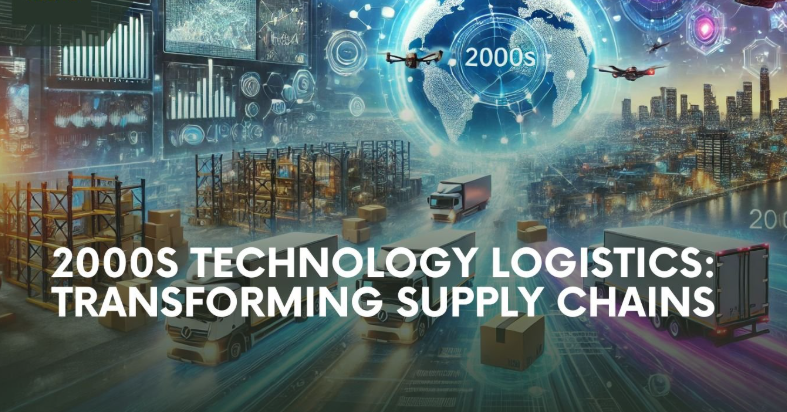The logistics industry has experienced significant advancements in technology over the past few decades, particularly in the 2000s. These changes have reshaped the way goods are transported, tracked, and managed, making logistics more efficient and cost-effective. In this blog post, we will explore the key developments in logistics technology in the 2000s, how they impacted businesses, and what trends continue to shape the future of logistics.
The Rise of Logistics Technology in the 2000s
The 2000s marked a pivotal point in the logistics industry, as technology became central to improving operations. Companies began adopting new digital tools to streamline processes, reduce costs, and enhance the customer experience. The key advancements in logistics technology during this period included the widespread use of GPS, warehouse management systems (WMS), automated supply chains, and real-time tracking. These innovations transformed the industry, creating a more connected and efficient global supply chain.
Key Developments in Logistics Technology in the 2000s
-
The Emergence of GPS and Real-Time Tracking
One of the most transformative technologies in logistics during the 2000s was the widespread adoption of GPS (Global Positioning System) technology. Prior to the 2000s, tracking shipments and vehicles in real-time was a challenge. Businesses often relied on outdated methods, such as paper logs and phone calls, to track deliveries.
With the introduction of GPS tracking systems, logistics companies could now monitor their shipments and fleets in real-time. GPS technology allowed for better route planning, reducing delivery times and fuel costs. Furthermore, it enabled real-time updates for customers, increasing transparency and improving customer satisfaction. GPS also helped reduce theft and loss, as goods could be tracked from the warehouse to the final destination.
-
The Advent of Warehouse Management Systems (WMS)
Warehouse management systems (WMS) became a game-changer for logistics operations in the 2000s. WMS software is used to manage and optimize the storage, retrieval, and movement of goods within a warehouse. Prior to WMS, warehouses often relied on manual systems that were prone to errors and inefficiencies.
The development and adoption of WMS technology allowed logistics companies to streamline their inventory management. This technology automated processes such as order picking, inventory tracking, and stock replenishment, significantly reducing errors and improving speed. WMS also helped businesses track inventory levels in real-time, which improved supply chain efficiency and reduced stockouts.
As e-commerce grew during the 2000s, WMS technology became essential for handling the increased volume of online orders. E-commerce giants like Amazon were among the first to adopt advanced WMS solutions, setting new standards for logistics operations.
-
The Growth of Automated Supply Chains
The 2000s also saw the rise of automated supply chains. Automation in logistics refers to the use of technology to perform tasks that would traditionally require human labor. This includes the use of robotics, conveyors, and automated guided vehicles (AGVs) in warehouses and distribution centers.
Automation brought several benefits to logistics, including faster processing times, reduced labor costs, and improved accuracy. For example, automated picking systems, which use robots to pick products from shelves, became more common in warehouses. This technology helped companies handle higher volumes of orders while maintaining accuracy and efficiency.
The growth of automated supply chains was also driven by the increasing demand for just-in-time (JIT) inventory management. JIT systems require precise coordination between suppliers, manufacturers, and distributors. Automation played a key role in ensuring that goods arrived at the right time and in the right quantity.
-
The Expansion of E-Commerce and Online Shipping Solutions
The 2000s marked the rapid expansion of e-commerce, with online shopping becoming more mainstream. This growth had a direct impact on logistics technology, as companies sought ways to meet the demands of online consumers for faster and more efficient shipping.
E-commerce companies, such as Amazon, introduced new logistics technologies to streamline their operations. One of the key advancements was the development of sophisticated order management systems (OMS). These systems allowed e-commerce businesses to manage orders from multiple channels and track them in real-time. This ensured a smoother and more efficient order fulfillment process.
Shipping solutions also evolved in the 2000s, with the introduction of online tracking and shipping management platforms. These platforms allowed customers to track their shipments in real-time and receive updates on delivery status. Moreover, logistics providers began offering faster shipping options, such as same-day or two-day delivery, to compete with the growing expectations of online shoppers.
-
The Integration of Cloud Technology
The integration of cloud computing into logistics technology also began in the 2000s. Cloud-based systems allowed logistics companies to store and access data remotely, improving communication and collaboration across the supply chain.
Cloud-based warehouse management systems, for example, enabled real-time updates on inventory and order status. This technology also allowed for easier integration with other systems, such as transportation management and order fulfillment systems, creating a more seamless logistics network.
Cloud computing also facilitated better data analytics, allowing companies to make data-driven decisions. For example, logistics companies could analyze shipping routes, inventory levels, and customer preferences to optimize their operations and reduce costs.
How These Technologies Impacted Logistics Operations?
The technological advancements of the 2000s revolutionized logistics in several ways:
-
Improved Efficiency and Reduced Costs
By automating processes, using real-time tracking, and implementing cloud-based systems, logistics companies could reduce inefficiencies and lower operational costs. These technologies helped streamline supply chains, reducing delays and minimizing human errors. The ability to track shipments in real-time allowed for better route planning, reducing fuel consumption and travel time.
-
Enhanced Customer Experience
With advancements in logistics technology, customers were able to track their shipments in real-time, receive timely updates, and enjoy faster delivery times. This increased transparency and reliability improved the overall customer experience. E-commerce businesses, in particular, benefited from these technologies, as customers demanded faster shipping options and greater visibility into their orders.
-
Scalability for Growing Businesses
The adoption of logistics technologies allowed businesses to scale more easily. With tools like warehouse management systems and automated supply chains, companies could handle larger volumes of orders and expand their operations without needing to significantly increase labor or infrastructure costs. This scalability was crucial during the rapid growth of e-commerce in the 2000s.
-
Greater Collaboration Across the Supply Chain
Cloud-based systems and integrated logistics technologies made it easier for businesses to collaborate across the supply chain. Suppliers, manufacturers, and distributors could access the same information in real-time, improving communication and coordination. This level of collaboration helped businesses optimize inventory levels, reduce stockouts, and improve the overall efficiency of the supply chain.
Conclusion
What Has Happened in Logistics Technology in the 2000s? The 2000s were a transformative decade for logistics technology. From the introduction of GPS tracking to the widespread adoption of automated supply chains and cloud-based systems, technology revolutionized the way logistics companies operate. These innovations led to faster, more efficient, and more cost-effective logistics processes, benefiting both businesses and consumers.
As the logistics industry continues to evolve, it is clear that technology will remain at the forefront of innovation. With the rise of artificial intelligence (AI), machine learning, and the Internet of Things (IoT), the future of logistics technology looks even more promising. Companies that embrace these technologies will continue to gain a competitive edge in the rapidly changing global market.
FAQs
What role did GPS play in logistics technology in the 2000s?
GPS technology allowed logistics companies to track shipments and fleets in real-time, improving route planning, reducing fuel costs, and enhancing customer satisfaction.
How did warehouse management systems (WMS) change logistics operations?
WMS technology automated inventory management and order fulfillment processes, reducing errors and improving speed and accuracy in warehouses.
What was the impact of e-commerce growth on logistics technology?
The rise of e-commerce led to the development of advanced order management systems, faster shipping options, and improved tracking solutions to meet the increasing demand for quick and efficient delivery.
How did cloud technology benefit logistics companies in the 2000s?
Cloud computing allowed logistics companies to store and access data remotely, improving communication, collaboration, and data-driven decision-making across the supply chain.
What is the future of logistics technology?
The future of logistics technology includes the integration of AI, machine learning, and IoT, which will further optimize supply chains, improve automation, and enhance customer experiences.







